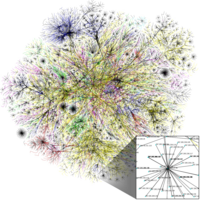
Photo from wikipedia
INTRODUCTION There is emerging research interest in exploring the relationship between distress intolerance and problematic Internet use, yet most of the existing studies are limited by cross-sectional design, convenience sampling… Click to show full abstract
INTRODUCTION There is emerging research interest in exploring the relationship between distress intolerance and problematic Internet use, yet most of the existing studies are limited by cross-sectional design, convenience sampling method, and poor understanding of the potential mediating and moderating factors involved. Based on the distress intolerance theory of addictive behavior and the theory of compensatory internet use, this study investigated a moderated mediation model to explain the impact of distress intolerance on problematic Internet use in adolescents. METHODS A three-wave longitudinal survey was conducted with 709 adolescents in Shanghai, China. The gender distribution was even, 50.2% were boys and 49.8% were girls. The mean age at T1 was 14.79 years (SD = 2.87). RESULTS Distress intolerance at Time 1 was found to positively predict problematic Internet use at Time 3. This prospective relation was mediated by adolescents' coping motives for Internet use at Time 2. Further, the mediation effect of coping motives for Internet use was moderated by need frustration at Time 2. The moderated mediation model was statistically equivalent for both genders. CONCLUSIONS Findings of this study contribute to new knowledge and have practical implications for prevention and intervention of adolescent problematic Internet use.
Journal Title: Journal of adolescence
Year Published: 2022
Link to full text (if available)
Share on Social Media: Sign Up to like & get
recommendations!